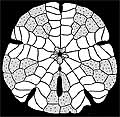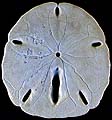The Echinoid Directory
Echinoglyphus Gray, 1852, p. 37
[=Moulinia L. Agassiz, 1841, p. 139, type species Scutella cassidulina Desmoulins, 1837, p. 78; = Moulinsia Agassiz, 1847 (non Grateloup, 1841); =Desmoulinaster Lambert & Thiery, 1914, p. 294, type species Scutella cassidulina Desmoulins, 1837, p. 78 ]
| Diagnostic Features |
|
|---|---|
| Distribution |
|
| Name gender | masculine |
| Type | Echinoglyphus frondosus Van Phelum [=Scutella emarginatus Leske, 1778] by monotypy. |
| Species Included |
|
| Classification and/or Status |
|
| Remarks | Mortensen, T. 1948. A Monograph of the Echinoidea IV.2 Clypeasteroida. C. A. Reitzel, Copenhagen. |



